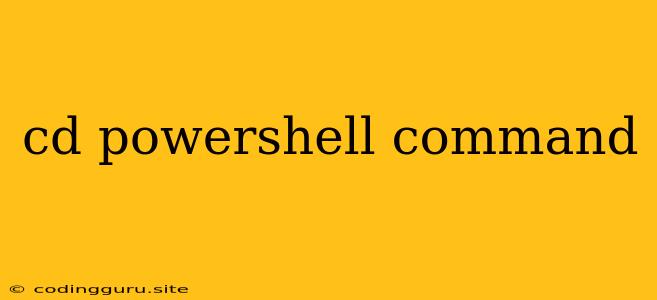Navigating Your Filesystem with the "cd" Command in PowerShell
PowerShell, a powerful command-line shell and scripting language, offers a robust way to manage your files and folders. One of the fundamental commands in PowerShell is cd, which stands for change directory. This command allows you to move between different directories within your file system.
Let's explore the cd command and its various uses:
Understanding the Basics of "cd"
What is the Purpose of "cd"?
The cd command is your navigator within the world of files and folders. It lets you shift your current working directory, the location where PowerShell is currently operating. Think of it as a way to tell PowerShell: "Hey, I want to work in this folder now!"
How to Use "cd"
The basic syntax for cd is simple:
cd
Replace <directory_path> with the path to the desired directory. For instance:
cd C:\Users\YourUserName\Documents
This command will move you to the "Documents" folder within your user profile.
Going Up and Down the Directory Tree
Moving Upwards:
To navigate up one level in the directory structure, use:
cd ..
This command will move you to the parent directory of your current location. You can use multiple ".." to navigate up multiple levels.
Moving Downwards:
To go into a specific subdirectory, simply use its name after cd. For example:
cd MyProjectFolder
This will take you to the "MyProjectFolder" directory if it exists within your current location.
Using Absolute and Relative Paths
Absolute Paths:
An absolute path provides the complete path to a directory starting from the root directory (e.g., C:\). For example:
cd C:\Users\YourUserName\Downloads
Relative Paths:
A relative path specifies a directory based on your current location. This is often more convenient for navigating within a specific project or directory structure. For example:
cd MyProjectFolder\Scripts
This command assumes "MyProjectFolder" is a subdirectory of your current location, and then further navigates to the "Scripts" subdirectory within it.
Working with the "cd" Command in Practice
1. Exploring Your System:
Use cd to move around different directories on your system. You can explore your user profile, program files, or any other location you need to access.
2. Navigating Projects:
In a development environment, cd is crucial for switching between project directories and working on different parts of your codebase.
3. Automating Tasks:
You can integrate the cd command into PowerShell scripts to automate tasks. For example, you could create a script that changes to a specific directory, runs a command, and then returns to the original directory.
Key Points to Remember
- Case Sensitivity: PowerShell is case-sensitive when working with directories. Make sure to use the correct capitalization.
- Directory Existence: Ensure the directory you're trying to change to exists before executing the cd command.
- Error Messages: If the directory does not exist or you encounter other issues, PowerShell will display error messages to help you troubleshoot.
Conclusion
The cd command is a fundamental tool for managing your files and directories in PowerShell. Mastering this command enables you to navigate your file system efficiently and effectively, making it a core skill for any PowerShell user. By understanding the concepts of absolute and relative paths, going up and down the directory tree, and using cd in practical scenarios, you'll gain greater control over your system and streamline your command-line operations.
